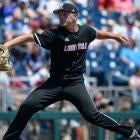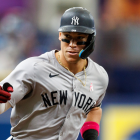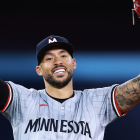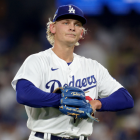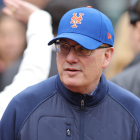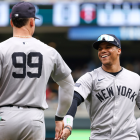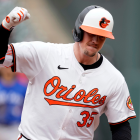Last week, Major League Baseball announced the 2020 draft would begin on June 10, and that it would last just five rounds. While that's a departure from the norm (and not in a good way), we here at CBS Sports will be providing coverage up through the draft.
That process began on Monday, with a ranking of the top 25 position players in the class. It continues today, as we'll rank the top 25 pitchers; on Friday, we'll focus on the top 50 prospects in this class.
Before we get to the rankings, we're legally obligated to offer a few caveats: 1) these were formed through a combination of insight gleaned from scouts and executives, as well our own analysis of the players; and 2) these are not supposed to align exactly with the actual draft order; their expected draft range was a consideration, however, along with their talent level and overall potential.
With that in mind, let's rank some pitching prospects.
1. Asa Lacy, LHP, Texas A&M
Over the last three seasons, six left-handed starters have averaged 150 innings and more than a strikeout per inning: Chris Sale, Robbie Ray, Patrick Corbin, Eduardo Rodriguez, Clayton Kershaw, and Matthew Boyd. Lacy, who struck out 46 batters in 24 innings this season, seems primed to join that group in the coming years. At minimum, he has the highest upside and the best shot at realizing it among the pitchers in the class. Lacy's repertoire features four usable or better pitches, including a low-to-mid-90s fastball and a slider that each grade as elite offerings, according to Trackman data. He also has the frame and demeanor scouts seek in their top-of-the-rotation prospects. The major (and arguably only) flaw in his game is his command: even though he walked three batters per nine in this abbreviated season, he still finished his Aggies career having walked four per nine. If Lacy can improve in that regard, he has the weaponry to become a frontline starter. Otherwise, he'll likely settle in as a mid-rotation starter who has stretches and seasons where he teases more (think the aforementioned Ray).
Asa Lacy, 14Ks in 5IP (in 36 seconds). 🔥 pic.twitter.com/9LUPj1qaLa
— Rob Friedman (@PitchingNinja) February 22, 2020
2. Emerson Hancock, RHP, Georgia
Hancock does not have Lacy's top-end potential because he does not have Lacy's two top-end pitches. He might have the higher floor, however, thanks to a well-rounded arsenal and a better feel for throwing strikes. Hancock has three pitches that could be classified as above-average: his low-to-mid-90s fastball, his changeup, and his slider. His delivery features some recoil, yet he walked just over seven percent of the batters he faced in three years against top-end SEC competition. (Lacy, in the same conference, walked nearly 11 percent.) Of course, Hancock should be allowed to exist outside of the comparisons to Lacy. He's a high-quality pitcher who ought to hold down a big-league rotation spot for years to come, beginning sooner than later.
3. Max Meyer, RHP, Minnesota
Call Meyer the Murder Hornet because he's small but fierce. He's about Sonny Gray-sized, yet he has well-above-average arm strength that lets him touch the upper-90s, and a wipeout slider that is one of the best secondary pitches in the draft. If asked, he could probably pitch out of a big-league bullpen this season. Obviously the long-term hope for Meyer is that he's a frontline starter. He can't do anything about his height, so he'll need to improve his changeup and perhaps tweak his delivery so he doesn't land quite as open. Given his athleticism and pair of top-end pitches, he has a better chance than most at defying the stigma against short righties.
4. Mick Abel, RHP, Jesuit (HS)
Abel figures to become the highest prep right-hander drafted since Hunter Greene went No. 2 in the 2017 draft. (Carter Stewart, who didn't sign and now plays in Japan, was selected eighth overall in 2018.) He'll do that despite the pandemic wiping out his season, and preventing teams from taking additional looks. Based on their past observations, Abel has a chance to be a high-quality big-league starter. He has a tall, lean frame that ought to support muscle gain over the coming years; he's a good athlete who can repeat his delivery, boding well for his command and control; and his arsenal includes three flowering pitches: a lively fastball that can bump the upper-90s and a slider and a changeup. The top of this class is loaded with good college arms, so Abel might slip outside of the top five. Whatever team gets him should be thrilled.
Curveball Porn/NSFW
— Rob Friedman (@PitchingNinja) March 7, 2020
11 Reid Detmers Curveballs from Last Night's 15K/6IP outing. pic.twitter.com/my8YHoOXC4
5. Reid Detmers, LHP, Louisville
Louisville has produced a pair of top-five picks in recent years, in outfielder Corey Ray (No. 5, 2016) and two-way-player Brendan McKay (No. 4, 2017). Those two are the only Cardinals ever taken in the top 20, let alone the top 10. Detmers will change that this summer. He finished his career at Louisville with a four-start stretch that saw him post a 1.23 ERA and strike out 19.6 batters per nine innings. You read that right: he fanned more than two per inning, or 48 of the 91 batters he faced, and he did that while allowing 16 hits, three runs, and six walks. Detmers, whose delivery and high three-quarters release will remind some of Drew Smyly or Tarik Skubal, pairs a low-90s fastball with a slow, knee-buckling curveball. Scouts have concerns that the curve won't be as effective against big-league hitters due to its low-to-mid-70s velocity and its out-of-hand visibility. Detmers could help his own case by nursing along his slider and changeup. Should he prove successful, he ought to be a quick-to-rise mid-rotation starter.
6. Nick Bitsko, RHP, Central Bucks East (HS)
No pitcher ranked this highly on this list has less on file than Bitsko does. He reclassified earlier in the year from the 2021 draft, putting the onus on his performance this spring. That decision could have played in his favor under normal circumstances, but the spread of the novel coronavirus caused his season to be canceled. He's still a candidate to go high in the draft because of what teams saw in the past: a good, physical frame; a clean delivery; a hot fastball; and a curveball that looks good through the lens of Trackman. Bitsko has to be convinced to forego his commitment to the University of Virginia, meaning whatever team takes him will have to put its money where its confidence is. It could pay off, and some, if that team is right.
7. Garrett Crochet, LHP, Tennessee
Crochet missed the onset of the season due to injury, meaning his first start of the year doubled as his last. The availability heuristic might work against him on draft day: teams will ostensibly view him as a starter, but he opened in just 13 of his 36 appearances over three years with the Volunteers. To Crochet's credit, he does have the essential attributes teams desire in their starters: a big frame (6-foot-6), a strong arm (he can flirt with triple digits), and an out pitch (his slider). Should he fail in the rotation, he'd probably make a mighty fine setup man.
8. Tanner Burns, RHP, Auburn
Burns was on pace to lead the Tigers in innings pitched for a second consecutive season prior to the pandemic. He also finished second (behind No. 1 pick Casey Mize) in that category during his freshman year. That's a comforting run of durability for a pitcher who is listed at 6-foot and who has missed time due to shoulder soreness. Burns has other things going for him, too: an average or better three-pitch mix, a sturdy frame, and nearly 200 innings' worth of high-quality work (2.86 ERA, 3.13 strikeout-to-walk ratio) against SEC competition. He should go in the first round, and should be able to step into the middle of a rotation before long.
9. Cade Cavalli, RHP, Oklahoma
Cavalli is a former two-way player who looks good in the uniform and who hit .319/.393/.611 in 2019. Focusing exclusively on pitching this year paid off, as he showed improved control by walking five batters in 23 innings; he'd previously walked five per nine in 90-plus innings between Oklahoma and the Cape Cod League. Cavalli has a fastball he can run into the mid-to-upper-90s as well as a quality slider. He needs to work on his changeup and command, and to prove he's durable enough to start, but he's an intriguing prospect who should go early.
10. Jared Kelley, RHP, Refugio (HS)
Kelley's physicality is unmatched among prep arms. He's big and stout and looks like he could give a team seven strong if he was given a day's notice. He's likely to be one of the first prep arms off the board on draft day thanks to his mid-to-upper-90s fastball and a high-grade changeup. Typically, the top high-school arms have a breaking ball as their best secondary pitch. That jives with the rule of thumb that states any pitcher can be taught a changeup with enough repetitions, but that spinning the ball is an innate skill. (It would be fair to propose that he could just learn a cutter if his breaker fails to materialize.) Kelley has one other notable concern working against him that isn't his fault: the failures of pop-up prep arms in recent years. Maybe Kelley will turn into the next Tyler Kolek. Some team will gladly take that chance.
11. Chris McMahon, RHP, Miami
McMahon, a three-sport athlete in high school, has the potential to make a team happy in the later portions of the first round. He could have three above-average offerings at his maturation, with a good fastball and changeup and a promising breaking ball. Over the course of his collegiate career, he struck out more than a batter per inning and proved to be difficult to square up, as he allowed just four home runs in 112 innings. McMahon did miss time as a freshman due to a knee injury, and his delivery features a high elbow that could ostensibly cause him harm down the road. Still, he should be a quick-moving big-league contributor with upside.
12. J.T. Ginn, RHP, Miss State
Ginn entered the spring as a potential top-10 pick on the strength of his fastball-slider pairing and his freshman season with the Bulldogs (3.13 ERA and 5.53 strikeout-to-walk ratio). Unfortunately, his lofty standing lasted as long as his season did: a single start. He underwent Tommy John surgery in early March, right before the spread of the novel coronavirus, and he likely won't return to the mound until next summer. Scouts believe he's likely to go high enough to justify signing. He's a draft-eligible sophomore, so don't expect him to come super cheaply.
JT Ginn, Sinker (with tail). pic.twitter.com/ABEHF4pNuN
— Rob Friedman (@PitchingNinja) June 21, 2019
13. Carmen Mlodzinski, RHP, South Carolina
Mlodzinski doesn't have an extensive track record to offer scouts. He was limited to 14 starts over parts of three years, with 10 of those coming during his shaky freshman and injury-shortened (broken foot) sophomore seasons; hence his career 4.74 ERA. Mlodzinski is still likely to be picked early on thanks to his athleticism; his performance in last year's Cape Cod League; and his arsenal, which could feature three above-average pitches: sinker, cutter, slider. It doesn't hurt that he might have the best head of hair among pitching prospects, either.
14. Jared Shuster, LHP, Wake Forest
Few, if any pitchers in this class have improved their stock as much as Shuster has over the past year. Despite walking nearly five batters per nine in 2019, he's walked just nine batters over his last 11 appearances, dating back to the Cape Cod League. His precision gains have coincided with a velocity boost that enables him to touch into the mid-to-upper-90s. Factor in Shuster's durable frame and the rest of his arsenal (a high-grade changeup and slider), and he has a real chance to go late in the first round, which would've been unthinkable a June ago.
15. Cole Wilcox, RHP, Georgia
For as good as Hancock was during the abbreviated season, it was Wilcox who led the Bulldogs in strikeout-to-walk ratio (16). That accomplishment was a departure from the wildness he showed during his freshman and Cape Cod League efforts, when he walked nearly 15 percent of the batters he faced. Wilcox has top-shelf arm strength, and a promising slider. His delivery features enough effort that scouts think he'll wind up in the bullpen, but he should get a chance to start at the onset of his career.
16. Bryce Jarvis, RHP, Duke
Jarvis received a lot of attention in February, when he threw a perfect game against Cornell. He followed up that start with a pair of dominating performances against Purdue and Florida State that brought his seasonal totals to 27 innings, 11 hits, two walks, two earned runs, and 40 strikeouts. Jarvis has improved his velocity, now pitching in the mid-90s, and he has one of the draft's best changeups. His slider is also a quality offering, giving him three legit weapons. His uptempo delivery is a little awkward, and he has a history of walking more than four batters per nine. Teams will likely give him the benefit of the doubt in that regard, given his hard work and marked improvement in other areas, with someone eyeing him as a mid-rotation starter.
"Mr. Perfect" Bryce Jarvis, highlights.
— Rob Friedman (@PitchingNinja) March 14, 2020
0.67 ERA, 40Ks/2BBs in 27IP. .120 BAA. and a perfect game this season for @DukeBASE @BryceJarvis28
[Bullpen to follow] pic.twitter.com/HgIA1daa8G
17. Logan Allen, LHP, FIU
Allen has a common name for baseball players, but he has an uncommon profile for this list. He's on the short and lean side (6-foot, 180 pounds) with a fastball on the slow side (low-90s). Yet Allen could go earlier than his raw stuff indicates he should because of his polish. He has good command, a plus changeup, and the utmost confidence in his ability on the mound. He isn't going to be anyone's ace, but he knows how to pitch and should reach the majors quickly.
18. Slade Cecconi, RHP, Miami
The other Hurricanes starter in the top-25, Cecconi has the size and arm talent to be a value addition for a team picking later in the draft. He's listed at 6-foot-4 with a frame that suggests he should be able to eat innings at full maturation. Stuff-wise, he's able to touch into the upper-90s with a plethora of secondary offerings, including a swing-and-miss breaking ball. The biggest knocks on Cecconi are his inconsistency and his delivery, which sees his elbow get above his shoulder. That quirk helps to explain his so-so command, and is believed to be a precursor to injury. Cecconi could still prove to be a good get, especially if he slips into the second round.
19. Clayton Beeter, RHP, Texas Tech
Beeter is one of the most intriguing arms in the class. During an uneven freshman season spent in relief, he struck out (40) or walked (20) more than 64 percent of the batters he faced. Beeter joined the rotation this season, and he showed much improved control over four starts. His stuff is beyond questioning: his Trackman metrics are absurd, with his curveball possessing spin rates that would be elite among big-league pitchers; his command is more suspect, and his arm is often late to get up. A team enamored by his upside could pop him earlier than his track record suggests, but they'll do so knowing he could just be a reliever when all is said and done.
20. Dax Fulton, LHP, Mustang (HS)
Fulton underwent Tommy John surgery last September, but he could still be picked by a team willing to buy him out of his Oklahoma commitment. He possesses several of the foundational building blocks teams look for in starters: a big frame; a good fastball; a promising curveball; and so on. A team with multiple early round picks seems likeliest to pull the trigger.
21. Carson Montgomery, RHP, Windermere (HS)
Montgomery already possesses a starter's frame, at 6-foot-2 and nearly 200 pounds. He has other innate qualities teams desire in their rotation arms, too, like the raw spin on his pitches and the ability to touch the mid-90s with his fastball. Montgomery will need to work on his changeup and his command, and he'll have to be convinced to leave his Florida State commitment in the past, but whatever team commits could benefit in the long run.
22. Bobby Miller, RHP, Louisville
Miller has a big, strong frame. He has a firm fastball with plenty of oomph. He has a pair of average or better secondaries. And so on. What's not to like? Mostly his delivery, which includes a long, whip-like arm action that robs him of command and could threaten his long-term wellbeing. Some team that believes in his ability to stick in a rotation could take him earlier.
23. Justin Lange, RHP, Llano (HS)
Lange, a lean and athletic righty, put himself on the radar earlier this spring by hitting triple digits. Most of his promise remains unrealized, especially his feel for throwing strikes and secondary pitches. In other words, he's going to be a long-term upside play for whomever picks him. Lange has a commitment to Dallas Baptist, and while that program doesn't have the biggest name, it is known for helping pitchers get the most out of their arsenals. As such, even if Lange doesn't turn pro now, he could crack this list again in a few summers' time.
24. Jared Jones, RHP, La Mirada (HS)
Baseball is in Jones' blood. His father played in the Arizona Diamondbacks organization; his mother was a collegiate softball player; and two of his cousins (Randy and Ron Flores) pitched in the majors. Predictably, Jones is a stellar athlete who has also impressed in the outfield with his arm and legs. On the mound, he's been clocked up to 98 mph, and he's shown the makings of an above-average slider. Jones is even willing to tinker with the tempo of his delivery, a la Marcus Stroman or Johnny Cueto, to disrupt hitters' timing. Because he's just 6-foot-1, and because his delivery requires effort, some scouts think he'll end up in the bullpen. His youth, athleticism, and upside will convince a team to let him begin his career in a rotation.
25. Burl Carraway, LHP, Dallas Baptist
Everyone else on this list is a reliever as a fallback option. Not Carraway. He pitched out of the bullpen in 37 of his 38 appearances at Dallas Baptist, and he is certain to remain in that role as a professional. Carraway has an upper-90s fastball and a slow curve that he used to great effect for the Patriots, striking out 15.6 batters per nine for his career.
Burl Carraway is through two scoreless innings with four strikeouts!
— DBU Baseball (@DBU_Baseball) May 12, 2019
DBU 0, INS 0, Mid 2 pic.twitter.com/zngUknweY7
He does have below-average command (which might not surprise anyone who has seen his high-tempo, crossfire delivery), and he'll need to find the zone more often as he progresses. The upside here is a quick-moving late-inning dynamo, and with due respect to CJ Van Eyk and Tommy Mace and the other capable starters who could easily slot in here, that's likely to get him popped sometime over the first 50 picks.













